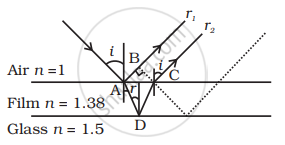Advertisements
Advertisements
Question
To ensure almost 100 per cent transmissivity, photographic lenses are often coated with a thin layer of dielectric material. The refractive index of this material is intermediated between that of air and glass (which makes the optical element of the lens). A typically used dielectric film is MgF2 (n = 1.38). What should the thickness of the film be so that at the center of the visible spectrum (5500 Å) there is maximum transmission.
Solution
Consider a ray incident at an angle i. A part of this ray is reflected from the air-film interface and a part is refracted inside. This is partly reflected at the film-glass interface and a part transmitted. A part of the reflected ray is reflected at the film-air interface and a part is transmitted as r2 parallel to r1. Of course, successive reflections and transmissions will keep on decreasing the amplitude of the wave. Hence rays r1 and r2 shall dominate the behaviour. If the incident light is to be transmitted through the lens, r1 and r2 should interfere destructively. Both the reflections at A and D are from lower to higher refractive index and hence there is no phase change on reflection. The optical path difference between r2 and r1 is n (AD + CD) – AB.
If d is the thickness of the film, then
`AD = CD = d/cos r`
`AB = AC sin i`
`(AC)/2` = d tan r
∴ `AC = 2d tan r`
Hence, `AB = 2d tanr sini`
Thus the optical path difference is

`2n d/cos r - 2d tan r sin i`
= `2. sin i/sin r d/cos r - 2d sinr/cos r sin i`
= `2d sin [(1 - sin^2r)/(sinr cos r)]`
= `2 nd cos r`
For these waves to interfere destructively this must be `λ/2`.
⇒ `2nd cos r = λ/2`
or `nd cos r = λ/4`
For a camera lens, the sources are in the vertical plane and hence `i ≃ r ≃ 0`
∴ `nd ≃ λ/4`
⇒ `d = (5500 Å)/(1.38 xx 4) ≃ 1000 Å`
APPEARS IN
RELATED QUESTIONS
For a glass plate as a polariser with refractive index 1.633, calculate the angle of incidence at which light is polarised.
Show, with the help of a diagram, how unpolarised sunlight gets polarised due to scattering.
Using the phenomenon of polarisation, show how the transverse nature of light can be demonstrated.
Show, via a suitable diagram, how unpolarised light can be polarised by reflection.
Two polaroids P1 and P2 are placed with their pass axes perpendicular to each other. Unpolarised light of intensity I0 is incident on P1. A third polaroid P3 is kept in between P1 and P2 such that its pass axis makes an angle of 60° with that of P1. Determine the intensity of light transmitted through P1, P2 and P3.
Explain how an unpolarised light gets polarised when incident on the interface separating the two transparent media.
What is a polariser?
What is partially polarised light?
An unpolarised light of intensity 32 Wm-2 passes through three Polaroids such that the axes of the first and the last Polaroids are at 90°. What is the angle between the axes of the first and middle Polaroids so that the emerging light has an intensity of only 3 Wm-2?
A polarizer - analyser set is adjusted such that the intensity of light coming out of the analyser is just 10% of the original intensity. Assuming that the polarizer - analyser set does not absorb any light, the angle by which the analyser need to be rotated further to reduce the output intensity to be zero, is ______.
